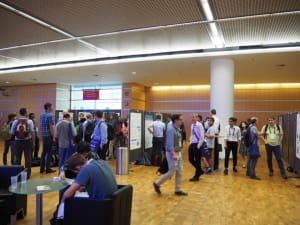CLEO/Europe-EQEC 2017 Atsuhiro Hori
Research
CLEO®/Europe-EQEC 2017 Participation Report
Master2Year: Atsuhiro Hori
About the Conference
We attended CLEO/Europe-EQEC 2017 held in Munich, Germany, from June 25 to 29. As this is a very large conference among optics-related conferences, there were many attendees, and during breaks, the café space in the venue and nearby restaurants were filled with people. Although I have never attended the sister conference CLEO, there seemed to be many presentations on the same topics as CLEO or on topics that have already been submitted to arXiv. After the presentations, beer, pretzels and cheeseburgers were handed out, and the conference dinner was held at a slightly remote venue, giving the impression of a very open conference. Contrary to the weather forecast before departure, we were blessed with relatively fine weather and enjoyed meals in the beer garden every evening. I felt that I did not want to see sausages and potatoes for a while (although they are very tasty).
2. regarding his/her own presentation
I gave a poster presentation on the interaction between transverse modes by induced Raman scattering in a silicatroid resonator. The presentation was given in a large hall and there was no oral session at that time, so the audience was larger than expected. My presentation was not well received by the audience, perhaps because of the rather niche nature of my presentation. I should have approached the audience myself to get them interested in my research, but I was very nervous because it was my first international conference, so it was difficult for me to talk to the audience. Fortunately, I received questions from several people who were interested in my research, but most of them were more basic questions than the detailed questions I had expected. I felt that it is quite difficult to explain in English in a way that is easy to understand for non-specialists.
3. regarding related research
Research on optical Kerr combs and solitons was presented mainly in the "Kerr solitons" and "Microresonators" sessions. After attending these sessions, I was reminded that there are two types of research: research that takes the high road (?), such as stabilization and control of the number of solitons to use optical Kerr combs as a substitute for optical frequency combs, and research that clarifies physical phenomena and leads to new applications. The other is a little bit more geeky research that aims at clarifying physical phenomena and connecting them to new applications." Temporal Dissipative Solitons in a Fabry-Perot Microresonator Drive by Optical Pulses" (T. Herr) and "Universal dynamics and deterministic switching of dissipative solitons" (T. Herr). Universal dynamics and deterministic switching of dissipative Kerr solitons in optical microresonators" (H. Guo) are exactly the former studies, which seem to have high impact and attention. Other researches, such as those on breathing solitons and super cavity solitons mainly using theory, and studies on the behavior of solitons in systems consisting of a large number of coupled micro optical resonators, fall into the latter category, and many of them seem to be in the latter category. I think it is very important to clarify detailed physical phenomena one by one, but I also felt that it is necessary to always keep an eye on what the research industry is aiming for, and to do research on the high road. In particular, since my research is somewhat maniacal and the research of my laboratory as a whole is somewhat in the latter direction, I felt that if I do not pay attention to my research, I may end up falling away from the trends of the industry.

- Categories
- 国際会議報告


